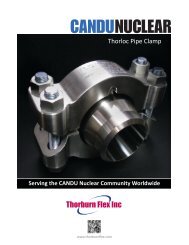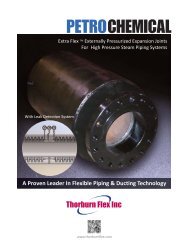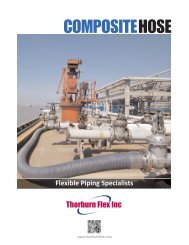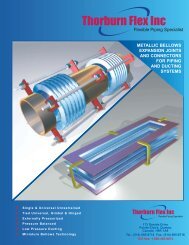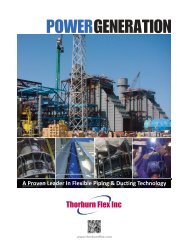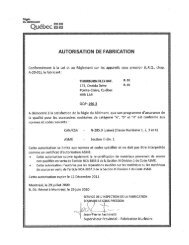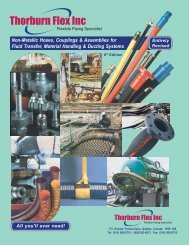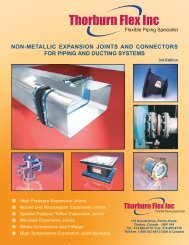Fittings & Adapters - Thorburn Flex Inc
Fittings & Adapters - Thorburn Flex Inc
Fittings & Adapters - Thorburn Flex Inc
Create successful ePaper yourself
Turn your PDF publications into a flip-book with our unique Google optimized e-Paper software.
Precision Machined “O” Seal<br />
Hose <strong>Adapters</strong> and Tube Fitting Bodies<br />
BRAZING INSTRUCTIONS FOR MAKING “O” SEAL TUBE FITTINGS<br />
Brazing<br />
Brazing joins metals by applying heat to a non-ferrous filler metal<br />
that melts above 800°F, but below the melting point of the base<br />
metal. Brazing differs from welding in that the filler metal is distributed<br />
by capillary action, whereas the filler metal in welding is fused<br />
where it is deposited. The process is based on the fact that a<br />
molten non-ferrous metal will form a strong bond with clean metal<br />
surfaces that have been heated to the right temperature.<br />
Brazing Materials<br />
Silver and copper alloy<br />
Choosing the proper tubing alloy<br />
Steel-seamless, #SAE1010, A179, fully annealed, also SAE welded<br />
and redrawn type suitable for bending. For maximum hardness,<br />
Rockwell B72.<br />
Stainless Steel-A269, A213, seamless, fully annealed and welded<br />
redrawn, fully annealed suitable for bending. For maximum<br />
hardness, Rockwell B90.<br />
PREPARATION AND CLEANING<br />
A. Preparing the Tube<br />
1. Establish the required length of<br />
tubing. Allow for insertion depth<br />
in the “O” Seal external shoulder<br />
by adding the proper length<br />
of straight unbent tubing to<br />
enter into the shoulder counterbore.<br />
The counterbore depth<br />
depends on the “O” Seal external<br />
shoulder size.<br />
“O” Seal Depth of<br />
External Counterbore<br />
Shoulder size (inches)<br />
-04 .25<br />
-06 .25<br />
-08 .38<br />
-10 .38<br />
-12 .38<br />
-16 .50<br />
-20 .50<br />
-24 .50<br />
2. Cut the tubing squarely (±1%) to<br />
the right length.The best tool for this<br />
is a tubing cutter, but a hacksaw or<br />
an abrasive wheel can be used<br />
3. Lightly deburr both the ID<br />
and the OD of the tube<br />
B. Preparing the Shoulder<br />
4. Clean the end of the tubing, using a liquid<br />
solvent, such as trichloroethane, denatured<br />
alcolhol, alkaline cleaner or equivalent.<br />
For proper use, follow the solvent<br />
manufacturer’s recommendation. Follow<br />
approved procedures for disposal. Avoid<br />
touching the tubing, because oily surfaces<br />
tend to repel the flux and silver<br />
material, leaving voids and inclusions.<br />
5. Polish tubing end to bare metal, using silicon<br />
carbide emery cloth. All oil and grease must<br />
be removed before the tube is polished (see<br />
4) because abrasives tend to scrub the oil<br />
into the surface and/or impregnate it with a<br />
fine abrasive powder, causing further contamination.<br />
Clean the tube end with either a<br />
clean solvent rinse or a soft oil-free cloth to<br />
remove the grit produced by the polishing.<br />
6. Degrease the shoulder<br />
thoroughly. Inspect for<br />
presence of rust. If rust<br />
present, follow the steps<br />
detailed previously to<br />
emery the counterbore.<br />
C. Preparing the BrazeRings D. Trial Assembly<br />
7. Degrease the rings thoroughly.<br />
Preformed silver braze rings (part number<br />
OS size-SB) are available from<br />
<strong>Thorburn</strong>, saving you time and simplifying<br />
the brazing process.If site-made rings are<br />
used, cut off a piece of silver wire just<br />
short of three times the counterbore’s<br />
diameter. For example, if the counterbore<br />
is 3 /4”,one cuts 2 3 /16”. If bulk wire is used, it<br />
must contain at least 45% silver content.<br />
Use needle-nose pliers to shape the silver<br />
wire into a ring.<br />
Braze Rings<br />
Silver braze rings. Specify SB for steel tubing<br />
and SB-SS for stainless steel tubing<br />
Size #<br />
<br />
<br />
<br />
<br />
<br />
<br />
<br />
<br />
<br />
<br />
<br />
<br />
<br />
<br />
<br />
<br />
<br />
<br />
<br />
<br />
<br />
<br />
<br />
<br />
<br />
<br />
8. Fit the shoulder onto the<br />
tube; it should fit freely for<br />
the full counterbore depth.<br />
<strong>Thorburn</strong> recommends<br />
.002” to.010” diametrical<br />
clearance. Avoid touching or<br />
contaminating surfaces.<br />
38





